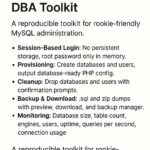Vertex AI Studio is a powerful, unified platform within Google Cloud that simplifies the entire AI development lifecycle. It serves as a central hub where developers, data scientists, and even those with minimal machine learning expertise can quickly prototype and test generative AI models. Instead of managing a complex array of separate tools, Vertex AI Studio brings everything into a single, intuitive interface. This allows you to explore foundation models, including the latest Gemini models, design and manage prompts, and fine-tune models with your own data. Ultimately, its purpose is to bridge the gap between an AI idea and a fully deployed, enterprise-ready application, making cutting-edge AI technology accessible and efficient for teams of any size.
Extract Video Chapters
Video chapters are an essential feature for long-form content, allowing viewers to quickly navigate to specific sections. Each chapter is defined by a timestamp and a descriptive title, turning a linear video into a structured, searchable document. For content creators and developers, extracting this data programmatically is key to building better user experiences, creating interactive transcripts, or analyzing video content at scale.
While you can’t get a list of chapters from the main YouTube Data API, you can still extract them by parsing the video’s description or using advanced tools like Google Cloud’s Vertex AI. This is because creators must manually add the chapters as a timestamped list in the video’s description to activate the feature on YouTube. This list serves as the primary source of the chapter data.
The most efficient way to capture this data for use in your applications is in a structured format like JSON (JavaScript Object Notation). JSON is a lightweight data-interchange format that is easy for humans to read and write and easy for machines to parse and generate. By structuring the chapters as a JSON array, you can define clear keys for each piece of information, such as the timestamp and title, making it simple to process and integrate.
Example: Chapters as Structured JSON
Let’s take a hypothetical video on website development. The JSON would represent a list of chapters, with each chapter being an object containing the start time and the chapter title.
[
{
"start_time": "00:00",
"title": "Introduction to Web Development"
},
{
"start_time": "02:15",
"title": "Choosing a Programming Language"
},
{
"start_time": "05:40",
"title": "Setting Up Your Development Environment"
},
{
"start_time": "10:30",
"title": "Building Your First Website"
},
{
"start_time": "15:05",
"title": "Understanding Front-End vs. Back-End"
}
]Summary of Video Chapters
Extracting video chapters into a structured format like JSON is a crucial step for turning a video into a dynamic data source. This process is the foundation for creating rich, interactive experiences for your audience and can significantly enhance the value of your video content.
To learn more about how developers can use the YouTube API to get video information, you can watch this video. API Tutorial For Beginners
Question answering about an image
Answering knowledge-extensive questions about an image is a core capability of advanced multimodal AI models. This goes far beyond simple image labeling, where the AI only identifies objects like “car” or “cat.” Instead, it requires the model to process both the visual information from the image and the semantic meaning of a complex question to provide an accurate, contextually relevant response.
For example, a knowledge-extensive question could be: “Based on the landmarks in this photo, which city was this taken in?” or “What year was this style of car manufactured?” To answer these, the AI model must recognize specific details in the image, such as architectural styles or vehicle models, and then access its vast internal knowledge base to connect those visual cues to the correct factual information. This ability to reason across different data types is a significant leap forward in artificial intelligence, enabling more sophisticated interactions between humans and AI systems.
AI Statistics
Based on recent data, here are some statistics related to Artificial Intelligence:
- The global AI market is projected to grow from an estimated $757.58 billion in 2025 to roughly $3.68 trillion by 2034, with a compound annual growth rate (CAGR) of about 19.20%.
- In 2024, 78% of global companies reported using AI in their business operations.
- Generative AI is a significant driver of growth, with its market projected to grow at a CAGR of 22.90% from 2025 to 2034.
- The use of generative AI in businesses increased from 33% in 2023 to 71% in 2024.
- According to some reports, AI could add $15.7 trillion to the global economy by 2030.
✍️ Need Content Like This?
We craft high-quality, SEO-optimized articles tailored for blogs, news sites, and educational platforms. If you enjoy thoughtful writing and open-source spirit, just buy me a coffee and I’ll write 1,000 words for you. Let’s build something meaningful together. Contact us to get started.

